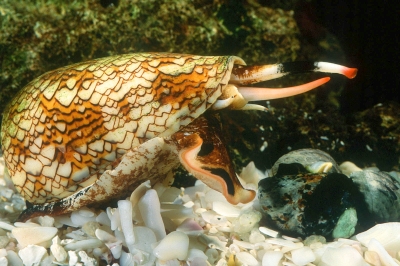  Cone snails are one of the most venomous creatures on earth. Of those, the textile cone snail, or 'cloth of gold' snail, may have the most potent venom known to science.
Cone snails are one of the most venomous creatures on earth. Of those, the textile cone snail, or 'cloth of gold' snail, may have the most potent venom known to science. They inhabit coral reefs, mostly in the Indian Ocean, as well as East Africa, the Red Sea, and around Australia and New Zealand. About 10 cm long, their shells are covered in ornate golden feather patterns. They eat snails and other molluscs. Even though they have eye stalks either side which can peer outside of their shell, they hide within the sea bed sediment with just their siphon sticking out, which acts as a breathing tube. They use this to hunt by scent. They’re armed with a harpoon containing a combination of venoms than can kill. It’s possible that the venom inside a single snail is enough to kill 700 people. The snails are quick to sting, and their harpoon-like stingers can pierce wetsuits. The sting is sometimes almost painless, but quickly followed by paralysis. Sometimes it's painful and comes with multiple other symptoms. However, the painless nature of many of the stings has led to a curious discovery. There's a significant pain-killing component to textile cone venom, and this has shown promising potential as an acute pain treatment for people who don't respond to opiates. It's suggested that the venom has similar effects to morphine, but without the risk of addiction. The female lays several hundred eggs at a time, which hatch after about 16 days. After hatching, the larvae float around in the current for about 16 days, eventually settling at the bottom of the ocean. By this point their length is about 1.5 mm Predators of cone snails include sea turtles and rays. |